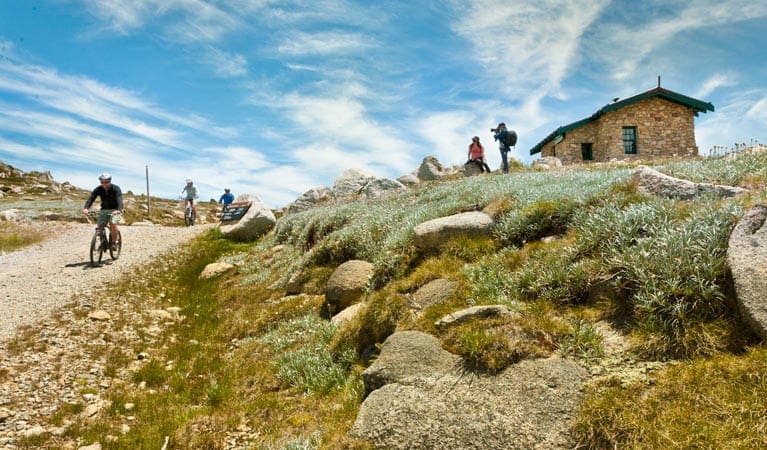Trail Fast Facts
Bluff Creek Nature Trail is a 4km, grade 3 hike in Burrowa-Pine Mountain National Park, Victoria. This hike typically takes 1.5 hours to complete.
Hike Overview
The Bluff Creek Nature Trail links the Bluff Creek visitor area with Bluff Falls and can be walked in either direction. For much of its route the track follows closely beside Bluff Creek through moist, ferny gullies and tall stands of Blue Gum trees. Interpretative panels along the way provide information on features of interest. Walking conditions are generally good although the section nearest the falls is steep in places. From Bluff Falls, either retrace your steps or return to the picnic area along the road and Wombat Track.
Camping
Basic visitor facilities are located at Bluff Creek, near the main entrance to the park, and also at Blue Gum Camp, Hinces Creek and Pine Mountain.
Track Grade
Grade 3 (Moderate) - Walks for Most Fitness Levels: Grade 3 on the AWTGS represents moderate walking tracks. These are ideal for walkers with some fitness who are comfortable with some hills and uneven terrain. While suitable for most ages, some bushwalking experience is recommended to ensure a safe and enjoyable experience. Tracks may have short, steep hill sections, a rough surface, and many steps. The total distance of a Grade 3 walk can be up to 20 kilometers.
Tips
The park has limited permanent water sources - carry adequate drinking water when walking.
Walking conditions can be rough and rocky areas slippery when wet - wear sturdy footwear.
Cliffs and rocky bluffs occur within the park - be alert near the edge and look out for falling rocks.
Remote walking tracks may be poorly defined - carry an adequate map and compass or GPS.
Longer walking tracks require a good level of fitness and experience
Map and GPX file
Max elevation: 656 m
Min elevation: 445 m
Total climbing: 212 m
Total descent: -212 m
Trail Location (trailhead)
Sorry, no records were found. Please adjust your search criteria and try again.
Sorry, unable to load the Maps API.
Getting there
The park is located approximately 120 km east of Albury-Wodonga and 25 km northwest of Corryong. It lies between the Murray Valley Highway and the Murray River. Access to many popular visitor areas is from the all-weather Cudgewa Bluff Road, which passes through the park and is a pleasant scenic drive.
From Corryong, take Parish Lane from the western side of town (signposted to the National Park). Not far out of town, Parish Lane becomes the Briggs Gap Road, and provides a scenic start to the day, with the bitumen leading over the range from Corryong to the Cudgewa Creek Valley.
Follow Briggs Gap Road through to the C548 (the Cudgewa - Tintaldra Road, about 12km from town) and turn right, following the valley floor route through to the Cudgewa North Road, going off to the left. This is signposted to the National Park, and leads through cleared farmland to another signposted turn-off (also to the left) indicating that Cudgewa Bluff Falls are about six kilometres away.
If you are driving to the base of the Falls, then you need to continue along the access track (past the Bluff Creek area), following this winding track for about 2.5km, past the Blue Gums camping area (much smaller than the Bluff Creek area, with a creek to cross before gaining access) to the small car park about 200m from the Falls. Note that the camping area at Blue Gums, and the car park referred to here, are not suitable for caravans or large motorhomes (there is inadequate space to turn around).
Photo gallery
If you have any photos from this hike and are happy to share them, please upload your .jpg files here.
Please note: Uploading photos does not transfer ownership of copyright away from you. If requested, you will be credited for any photos you provide and can ask they be deleted at any time.
About the region
The Burrowa-Pine Mountain National Park is a national park in the Hume region of Victoria, Australia. The 18400ha national park is situated approximately northeast of Melbourne and east of Albury-Wodonga. The park stretches between Walwa Creek in the north-west and Cudgewa Creek in the southeast , both tributaries of the Murray River. There you will find Pine Mountain, one of the largest monoliths in the southern hemisphere, which is 1.5 times the size of Uluru. Another peak is Mount Burrowye.
Similar trails nearby
Explore Safe
While planning your hike, it’s important to check official government sources for updated information, temporary closures and trail access requirements. Before hitting the trail, check local weather and bushfire advice for planned burns and bushfire warnings and let someone know before you go. Plan ahead and hike safely.
Let someone know
Adventure with peace of mind: Fill out your trip intentions form. Before you hit the trail, fill out an online form to privately send important details about your hike to your family or friends. If you don’t return on time, they can easily alert emergency services, preventing worry and ensuring a swift response. Hike with peace of mind and enjoy your outdoor adventure to the fullest. Be smart, be safe: Register your plans here.
Gear to consider
What you carry in your pack will depend on the weather, terrain, time of year, type of adventure, and personal preferences. Having trouble deciding what gear’s right for you? My free planning, food and packing checklists provide an introduction to things your could consider (as well as the Ten Essentials) on your day, overnight and multi-day adventures. Customise your kit according to your personal needs, always considering safety first.
Suggest an edit
Trail changed? New features discovered? Has the route changed? Trail permanently closed? Help fellow hikers by suggesting edits! Click above to update route descriptions, GPX file, trail features (like boardwalks), or access conditions (like parking availability). Help me keep the trails info fresh!
Weather
Acknowledgement of Country
Trail Hiking Australia acknowledges the Traditional Owners of the lands on which we hike and pay respects to their Elders, past and present, and we acknowledge the First Nations people of other communities who may be here today.











